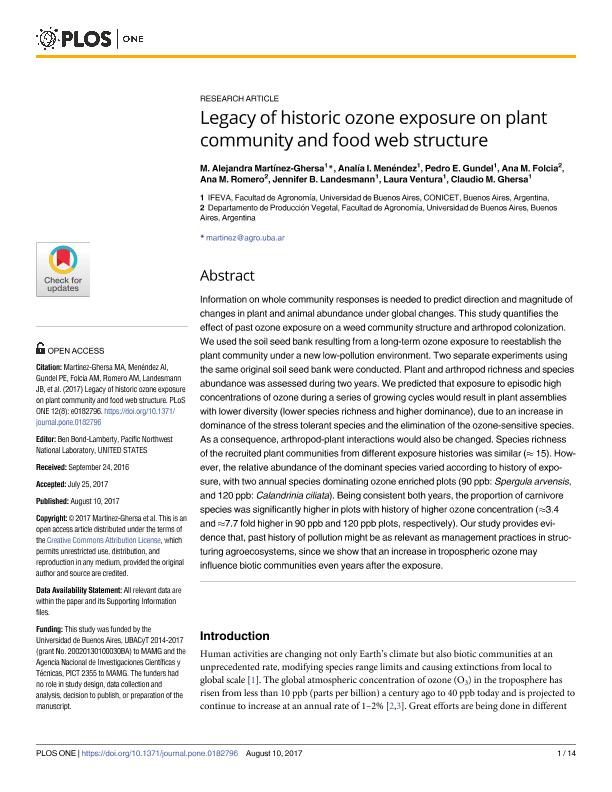Mostrar el registro sencillo del ítem
dc.contributor.author
Martinez-Ghersa, Maria Alejandra

dc.contributor.author
Menéndez, Analía I.
dc.contributor.author
Gundel, Pedro Emilio

dc.contributor.author
Folcia, Ana M.
dc.contributor.author
Romero, Ana María

dc.contributor.author
Landesmann, Jennifer Brenda

dc.contributor.author
Ventura Molina, Laura Isabel

dc.contributor.author
Ghersa, Claudio Marco

dc.date.available
2018-08-22T18:35:47Z
dc.date.issued
2017-08
dc.identifier.citation
Martinez-Ghersa, Maria Alejandra; Menéndez, Analía I.; Gundel, Pedro Emilio; Folcia, Ana M.; Romero, Ana María; et al.; Legacy of historic ozone exposure on plant community and food web structure; Public Library of Science; Plos One; 12; 8; 8-2017
dc.identifier.issn
1932-6203
dc.identifier.uri
http://hdl.handle.net/11336/56648
dc.description.abstract
Information on whole community responses is needed to predict direction and magnitude of changes in plant and animal abundance under global changes. This study quantifies the effect of past ozone exposure on a weed community structure and arthropod colonization. We used the soil seed bank resulting from a long-term ozone exposure to reestablish the plant community under a new low-pollution environment. Two separate experiments using the same original soil seed bank were conducted. Plant and arthropod richness and species abundance was assessed during two years. We predicted that exposure to episodic high concentrations of ozone during a series of growing cycles would result in plant assemblies with lower diversity (lower species richness and higher dominance), due to an increase in dominance of the stress tolerant species and the elimination of the ozone-sensitive species. As a consequence, arthropod-plant interactions would also be changed. Species richness of the recruited plant communities from different exposure histories was similar (≈ 15). However, the relative abundance of the dominant species varied according to history of exposure, with two annual species dominating ozone enriched plots (90 ppb: Spergula arvensis, and 120 ppb: Calandrinia ciliata). Being consistent both years, the proportion of carnivore species was significantly higher in plots with history of higher ozone concentration (≈3.4 and ≈7.7 fold higher in 90 ppb and 120 ppb plots, respectively). Our study provides evidence that, past history of pollution might be as relevant as management practices in structuring agroecosystems, since we show that an increase in tropospheric ozone may influence biotic communities even years after the exposure.
dc.format
application/pdf
dc.language.iso
eng
dc.publisher
Public Library of Science

dc.rights
info:eu-repo/semantics/openAccess
dc.rights.uri
https://creativecommons.org/licenses/by-nc-sa/2.5/ar/
dc.subject
Food Web
dc.subject
Global Change
dc.subject
Ecosystems
dc.subject
Arthropods
dc.subject.classification
Otras Ciencias Biológicas

dc.subject.classification
Ciencias Biológicas

dc.subject.classification
CIENCIAS NATURALES Y EXACTAS

dc.title
Legacy of historic ozone exposure on plant community and food web structure
dc.type
info:eu-repo/semantics/article
dc.type
info:ar-repo/semantics/artículo
dc.type
info:eu-repo/semantics/publishedVersion
dc.date.updated
2018-08-16T15:12:14Z
dc.identifier.eissn
1932-6203
dc.journal.volume
12
dc.journal.number
8
dc.journal.pais
Estados Unidos

dc.journal.ciudad
San Francisco
dc.description.fil
Fil: Martinez-Ghersa, Maria Alejandra. Consejo Nacional de Investigaciones Científicas y Técnicas. Oficina de Coordinación Administrativa Parque Centenario. Instituto de Investigaciones Fisiológicas y Ecológicas Vinculadas a la Agricultura. Universidad de Buenos Aires. Facultad de Agronomía; Argentina
dc.description.fil
Fil: Menéndez, Analía I.. Consejo Nacional de Investigaciones Científicas y Técnicas. Oficina de Coordinación Administrativa Parque Centenario. Instituto de Investigaciones Fisiológicas y Ecológicas Vinculadas a la Agricultura. Universidad de Buenos Aires. Facultad de Agronomía; Argentina
dc.description.fil
Fil: Gundel, Pedro Emilio. Consejo Nacional de Investigaciones Científicas y Técnicas. Oficina de Coordinación Administrativa Parque Centenario. Instituto de Investigaciones Fisiológicas y Ecológicas Vinculadas a la Agricultura. Universidad de Buenos Aires. Facultad de Agronomía; Argentina
dc.description.fil
Fil: Folcia, Ana M.. Universidad de Buenos Aires. Facultad de Agronomía; Argentina
dc.description.fil
Fil: Romero, Ana María. Universidad de Buenos Aires. Facultad de Agronomía; Argentina
dc.description.fil
Fil: Landesmann, Jennifer Brenda. Consejo Nacional de Investigaciones Científicas y Técnicas. Oficina de Coordinación Administrativa Parque Centenario. Instituto de Investigaciones Fisiológicas y Ecológicas Vinculadas a la Agricultura. Universidad de Buenos Aires. Facultad de Agronomía; Argentina
dc.description.fil
Fil: Ventura Molina, Laura Isabel. Consejo Nacional de Investigaciones Científicas y Técnicas. Oficina de Coordinación Administrativa Parque Centenario. Instituto de Investigaciones Fisiológicas y Ecológicas Vinculadas a la Agricultura. Universidad de Buenos Aires. Facultad de Agronomía; Argentina
dc.description.fil
Fil: Ghersa, Claudio Marco. Universidad de Buenos Aires; Argentina
dc.journal.title
Plos One

dc.relation.alternativeid
info:eu-repo/semantics/altIdentifier/url/http://journals.plos.org/plosone/article?id=10.1371/journal.pone.0182796
dc.relation.alternativeid
info:eu-repo/semantics/altIdentifier/doi/http://dx.doi.org/10.1371/journal.pone.0182796
Archivos asociados
